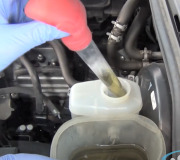No. No air will enter the system. Before you unbolt the caliper, all you have to do is use a large flat-blade screwdriver to pry the old pads away from the rotor to make room for the new, thicker pads. That pushes the piston back into the caliper housing, and that pushes out all the brake fluid that has entered the caliper to take up the space as the piston had run out as the old pads wore down over time. All that brake fluid will return to the reservoir and send it back up to "full". That's why we never add or top off the brake fluid during other routine services such as oil changes. Had someone added brake fluid, now it's going to overflow and make a mess.
The reason some professionals want to bleed some brake systems is brake fluid loves to absorb moisture out of the air, including through the rubber flex hoses, which are porous. That moisture promotes corrosion of internal metal parts, and it lowers the boiling point of the brake fluid from well over 400 degrees F. to closer to 212 degrees F., the boiling point of water. The brakes easily get over 200 degrees in normal operation. That heat migrates into the brake fluid, then the water vaporizes leading to one form of brake fade.
We like to do the bleeding after the new pads are installed and the pistons are adjusted out by pressing the brake pedal a few times. By starting with the fluid level near "full", then bleeding some out, it's easy to know how much new fluid to put back in. Just add until you reach the same "full" mark.
There's a real lot more to a professional brake job than simply slapping in a set of new pads. The first very important point to be aware of is to never push the brake pedal more than halfway to the floor, especially given the age of your vehicle. Crud and corrosion build up in the lower halves of the bores where the pistons don't normally travel in the master cylinder. Pushing the pedal over halfway runs the rubber lip seals over that crud and can rip them. That results in a slowly-sinking brake pedal, and that usually takes two or three days to show up. The fix for that is to replace the master cylinder.
This article provides more details on bleeding out some of the old brake fluid:
https://www.2carpros.com/articles/how-to-bleed-or-flush-a-car-brake-system
If the master cylinder does become damaged, here's an article that shows how to replace it:
https://www.2carpros.com/articles/how-to-replace-a-brake-master-cylinder
These articles go into more detail for replacing the pads:
https://www.2carpros.com/articles/how-to-replace-front-brake-pads-and-rotors-fwd
https://www.2carpros.com/articles/how-to-replace-rear-brake-pads-and-rotors
For your safety, please be sure to support the vehicle on jack stands. It might be a good idea to review this article:
https://www.2carpros.com/articles/jack-up-and-lift-your-car-safely
All of these, and more dandy articles can be found on this page:
https://www.2carpros.com/articles
Be careful to not get any grease on the rotor or pad friction surfaces. Also, it's critical that absolutely no type of petroleum product get mixed in the brake fluid. Professionals even wash their hands with soap and water before handling brake parts to prevent contaminating them with fingerprint grease.
For my final comment of value, if your vehicle has anti-lock brakes, it's especially important to not allow the reservoir to run empty when bleeding or flushing the brake fluid. If air works its way down to the hydraulic controller, you'll usually need a scanner to command the computer to open two valves to bleed the air that has pooled in two chambers. The procedure is shown on the scanner, and it doesn't take very long, but it can't be done without that scanner.
Let me know how this turns out or if you have more questions.
Monday, December 11th, 2023 AT 3:50 PM



